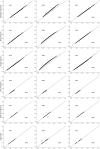Cardiometabolic Risk Increased in Working-Aged Adults During the COVID-19 Pandemic
- PMID: 37615613
- PMCID: PMC10615087
- DOI: 10.1089/met.2023.0044
Cardiometabolic Risk Increased in Working-Aged Adults During the COVID-19 Pandemic
Abstract
Background: Public health measures necessary to mitigate the spread of coronavirus disease 2019 (COVID-19) impacted lifestyles and health practices. This multiyear cohort analysis of U.S. working-aged adults aims to evaluate the impact of the COVID-19 pandemic on metabolic syndrome and explores contributing factors. Methods: This longitudinal study (n = 19,543) evaluated year-to-year changes in metabolic syndrome and cardiometabolic risk factors through employer-sponsored annual health assessment before and during the COVID-19 pandemic using logistic mixed-effects model. Results: From prepandemic to pandemic (2019 to 2020), prevalence of metabolic syndrome increased by 3.5% for men and 3.0% for women, across all ethnic groups. This change was mainly driven by increased fasting glucose (7.3%) and blood pressure (5.2%). The increased risk of metabolic syndrome was more likely to occur in individuals with an elevated body mass index (BMI) combined with insufficient sleep or physical activity. Conclusions: Cardiometabolic risk increased during the COVID-19 pandemic compared with before the pandemic in a working-aged adult population, more so for those with a high BMI, unhealthy sleep, and low physical activity practices. Given this observation, identification of risk and intervention (including lifestyle and medical) is increasingly necessary to reduce the cardiovascular and metabolic risk, and improve working-aged population health.
Keywords: blood pressure; employee health; health risk factors; metabolic syndrome; prediabetes; workplace health.
Conflict of interest statement
M.S.F., F.M., Z.C., and L.A.B. are employed by and have stock ownership in Quest Diagnostics.
Figures




Similar articles
-
Body mass index and prevalence of metabolic syndrome among Korean adults before and after the COVID-19 outbreak: a retrospective longitudinal study.Epidemiol Health. 2023;45:e2023081. doi: 10.4178/epih.e2023081. Epub 2023 Aug 29. Epidemiol Health. 2023. PMID: 37654163 Free PMC article.
-
Changes in lifestyle, adiposity, and cardiometabolic markers among young adults in Sweden during the COVID-19 pandemic.BMC Public Health. 2023 May 31;23(1):1026. doi: 10.1186/s12889-023-15998-w. BMC Public Health. 2023. PMID: 37259040 Free PMC article.
-
COVID-19 Pandemic Impact on Trajectories in Cardiometabolic Health, Physical Activity, and Functioning Among Adults from the 2006-2020 Health and Retirement Study.J Gerontol A Biol Sci Med Sci. 2022 Jul 5;77(7):1371-1379. doi: 10.1093/gerona/glac028. J Gerontol A Biol Sci Med Sci. 2022. PMID: 35106581 Free PMC article.
-
[Cardiovascular risk and cardiometabolic risk: an epidemiological evaluation].G Ital Cardiol (Rome). 2008 Apr;9(4 Suppl 1):6S-17S. G Ital Cardiol (Rome). 2008. PMID: 18773746 Review. Italian.
-
Obstructive sleep apnea: a cardiometabolic risk in obesity and the metabolic syndrome.J Am Coll Cardiol. 2013 Aug 13;62(7):569-76. doi: 10.1016/j.jacc.2013.05.045. Epub 2013 Jun 12. J Am Coll Cardiol. 2013. PMID: 23770180 Free PMC article. Review.
References
MeSH terms
LinkOut - more resources
Full Text Sources
Medical
